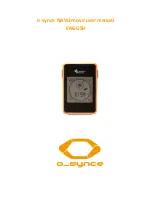
User Manual
User Manual
6
NOTE
2
SEP = Spherical Error Probability: The radius of the sphere, centered at the
antenna's True position, containing 50% of the fixes.
NOTE
3
One of this limit can exceeded but not both.
1.1.4 Environmental Characteristics
♦
Operating Temperature
: from 0°C to +60°C
♦
Storage Temperature
: from -20°C to +85°C
♦
Relative Humidity
: 95% non-condensing
♦
Water Resistance
: IPX7
1.2
WIRING
See the following tables for a functional description of each wire in the GPS cable.
1.2.1 Diagram for GSU with connector
SMART GPS
SENSOR
1
2
3 4 5
6
7
1
2
3 4 5
6
7
8
1
2
3 4
5
6
+10-35 Vdc
GPS RX+
GPS TX+
GND/COMMON
RED
GREEN
BROWN
BLACK/YELLOW/SHIELD
CABLE,
Wire Color
FUNCTION
1
2
3
6
7
1
2
3,6
CONNECTOR,
8 pins
CONNECTOR,
6 pins
Fig. 1.2.1 - GPS Connection for GSU with connector
1.2.2 Diagram for GSU
1
2
3 4
5
6
+10-35 Vdc
GPS RX+
GPS TX+
GND/COMMON
RED
GREEN
BROWN
BLACK/YELLOW/SHIELD
CABLE,
Wire Color
FUNCTION
1
2
3
6
CONNECTOR,
6 pins
SMART GPS
SENSOR
Fig. 1.2.2 - GPS Connection for GSU
WARNING!!!
Cross check the connection on the User Manual of the device connected
to the GPS.
1.3
SOFTWARE INTERFACE
The GPS products interface protocol design is based on the National Marine
Electronics Association's NMEA 0183 ASCII interface specification. These standards
are defined in "NMEA 0183 Version 2.0" (for more information see NMEA,
www.nmea.org).
7
1.4
MECHANICAL CHARACTERISTICS & MOUNTING
GSU
WITH CONNECTOR
MODEL
1.4.1 Installing
Choose a location for the antenna that has a clear view of the sky. Ensure there
are no major obstructions or fixtures in the immediate proximity to the antenna.
The antenna relies on direct “line of sight” satellite reception. If you are unsure
that the chosen location is suitable it may be advisable to mount the antenna in a
temporary manner to verify correct operation. The thread used on the antenna
(1", 14 TPI) is an industry standard thread used on a wide range of mounting
brackets, including the swivel joints commonly used for angled surfaces. However
due to the manufacturing process of these mounting brackets you may see that
there is some slop when tightening down the antenna to the bracket. This is of no
concern however as the antenna must be tightened until the antenna stops rotat-
ing on the antenna mounting bracket.
Fig. 1.4.1 - Installing GPS Antenna (I)
The antenna design also allows for easy flush mounting.
1. Apply the adhesive mounting template sheet in the area that was
verified to receive satellite signal well.
2. Then, following template instruction, drill a 1" (25 mm) hole and
three 0,13" (3.2 mm) holes.
GPS OVERALL SHAPE
Ø3.2mm
[0.13
”]
Ø25mm [1”]
Fig. 1.4.1a - Installing GPS Antenna (II)
3. Remove the template and let the cable go through the central
hole.
4. Apply a small coat of RTV to the underside of the antenna.
5. Place the antenna and then screw it with the three M3 screws.
























